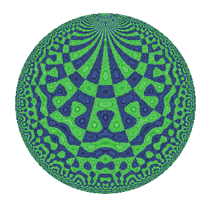Rigorous Maass forms are now in the $L$-functions and modular forms database LMFDB. This is something I've been working on for a while, and it's nice to actually make the data available. This naturally follows certain talks I've given before, include this one and this one, as well as various chalk talks over the last couple fo years.
The computations of the actual Maass forms uses work of Kieran Child, Andrei Seymour-Howell, and me. A variety of underlying techniques are used, including rigorous implementations of the Selberg trace formula, rigorous Hejhal's algorithm, and certification strategies.1 1See Certification of Maass cuso forms of arbitrary level and character by Child and Dimensions of the spaces of cusp forms and newforms on $\Gamma_0(N)$ and $\Gamma_1(N)$ by Booker, Strömbergsson, and Venkatesh. I haven't talked much about these before. And this all builds on the earlier heuristic approaches of Hejhal, later refined significantly by Strömberg, Lemurell, and Then. (And all data for $\mathrm{GL}(3)$ or $\mathrm{GL}(4)$ forms comes from completely different techniques of Farmer, Lemurell, and others).
See this short paper for some more information about the construction of the database.
For now, the Maass forms are on the LMFDB Beta. If nothing breaks (and I hope it won't), then they'll soon be on the main LMFDB too.
For the rest of this note, I want to describe a couple interesting facets of the newly available database.
Consecutive Maass Forms
One of our promises in the LMFDB is to not miss any Maass forms. For any given level, we have every Maass form with spectral parameter $0 < r < R$ for some $R$ (that currently depends strongly on the level). This guarantee comes largely from the trace formula: we can guarantee that we haven't missed any forms.2 2Or rather, any missing forms come from an implementation mistake, not a theoretical mistake.
Thus when you look at all Maass forms in some data range, we know that they are all there. This should be a big help with experimentation.
Labels
One advantage of having consecutive Maass forms is that we can label Maass
forms in a systematic way.
For a (cuspidal, Hecke, new) Maass form on $M_k(\Gamma_0(N), \chi)$, we assign
it the label N.k.a.m.d, where
- $N$ is the level,
- $k$ is the weight,
- $N.a$ is the Conrey label of the Dirichlet character $\chi$,
- $m$ is the spectral index, and
- $d$ is a disambiguation index if multiple Maass forms share the same earlier data. (This currently never happens).
The spectral index is the index of the spectral parameter $R$ in the list of all spectral parameters for a given weight, level, and character, starting from $1$ if $R > 0$. The special case when the spectral index $m = 0$ is reserved for Maass forms induced from Hecke characters. These are not currently in the LMFDB, but they will be at some point in the future.
In addition, if $k = 0$, $a = 1$, and $d = 1$, (which accounts for every Maass
form currently in the LMFDB), then we assign the short label N.m.
Labels in the LMFDB
Labels can be a big deal in the LMFDB. We don't like changing labels, ever. Once we give a form a name, we want that name to never change. This means that there can be big label discussions.
This time I tried designing what I thought was a robust label format, implementing it, and then asking for confirmation. This worked well! David Roe had the idea of adding the short label, which makes things look nicer.
Plots of Maass Forms
With new objects in the LMFDB, there comes new portraits.

These are similar to the portraits we made for classical modular forms. But the Maass forms we currently have are all real-valued, and thus only take on two separate hues. (And unlike the classical modular forms, we included hints at contours to indicate a bit more).
I overengineered portrait creation. I actually have a lot to say about it, and I'll write that down another time.
Check out the Maass Forms
So go forth and check them out! Right now they're on beta. If you manage to break anything, let me know and I'll fix it.
Happy mathing!
Leave a comment
Info on how to comment
To make a comment, please send an email using the button below. Your email address won't be shared (unless you include it in the body of your comment). If you don't want your real name to be used next to your comment, please specify the name you would like to use. If you want your name to link to a particular url, include that as well.
bold, italics, and plain text are allowed in
comments. A reasonable subset of markdown is supported, including lists,
links, and fenced code blocks. In addition, math can be formatted using
$(inline math)$ or $$(your display equation)$$.
Please use plaintext email when commenting. See Plaintext Email and Comments on this site for more. Note also that comments are expected to be open, considerate, and respectful.
Comments (1)
2024-06-05 DLD
Rigorous Maass forms are now on the (beta) of the LMFDB! Go check them out.
https://beta.lmfdb.org/ModularForm/GL2/Q/Maass/